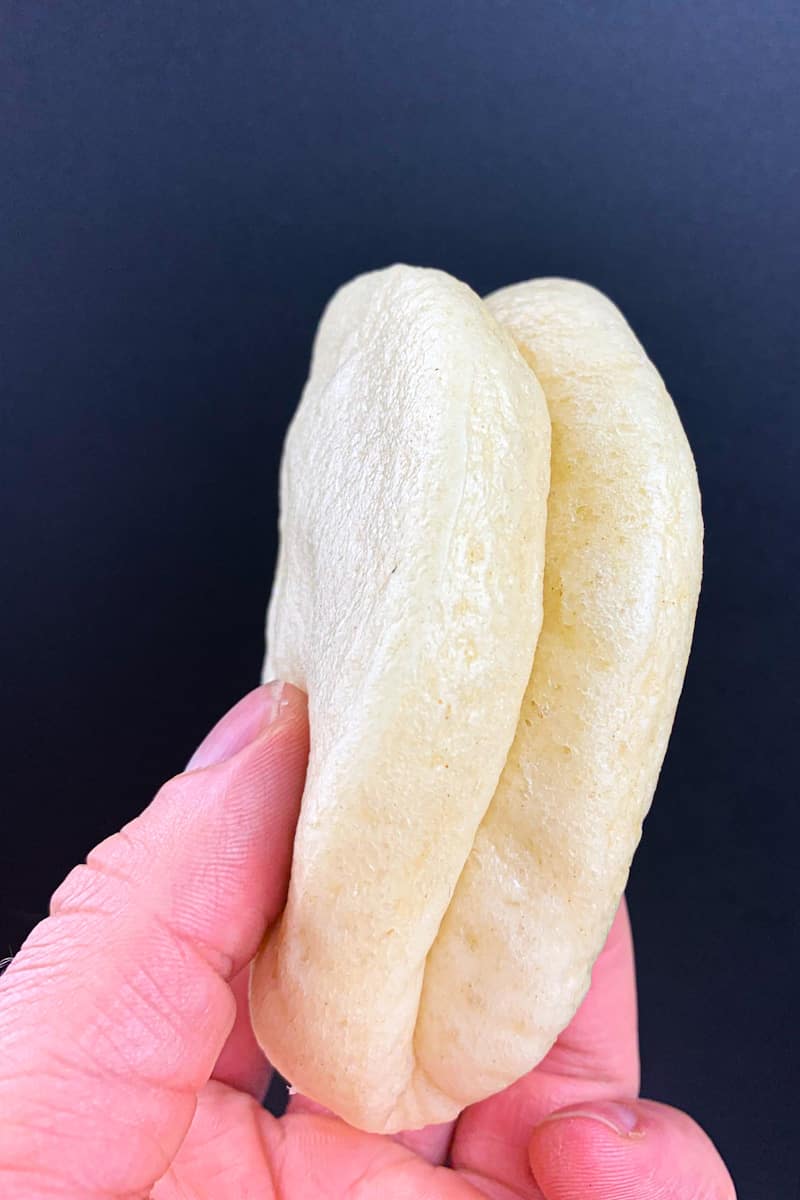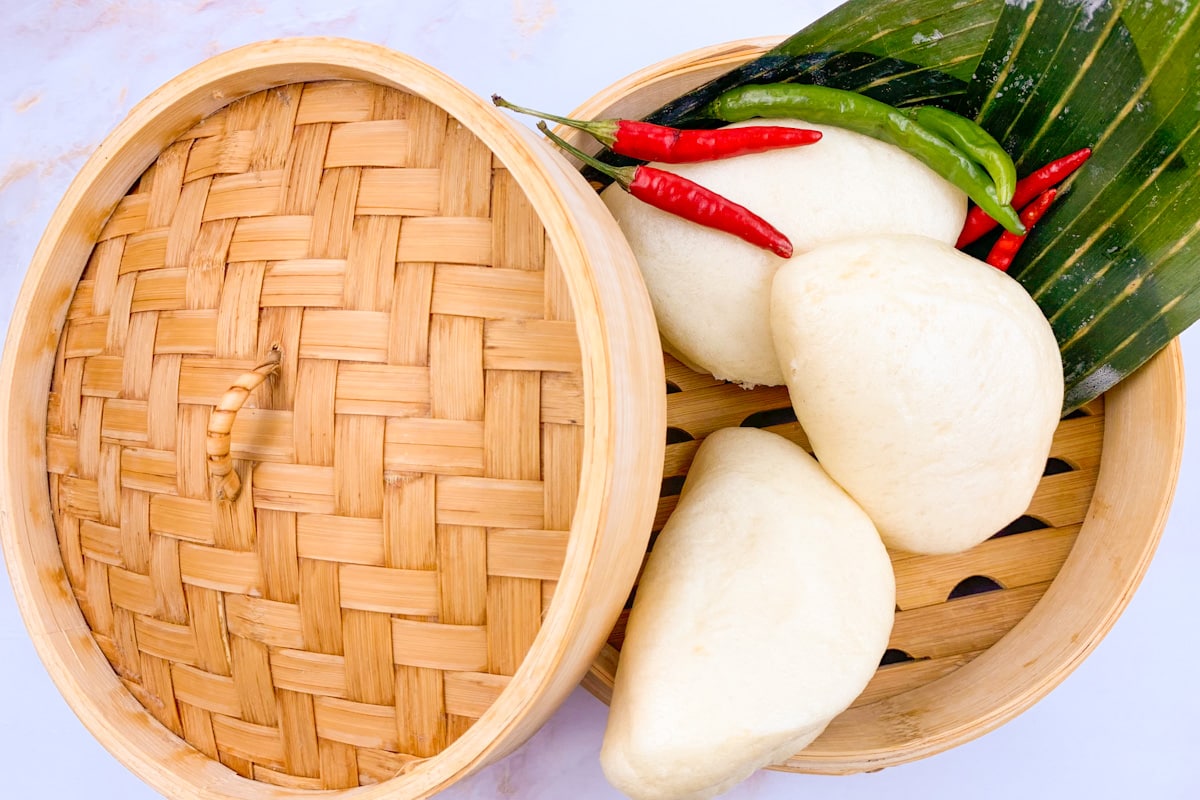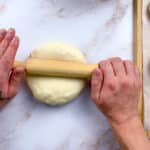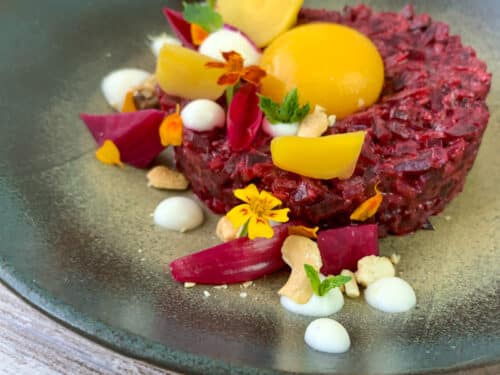What are Bao Buns and where do they come from
Nowadays famous in all parts of the world, the Bao Buns originate from the Fujian Province in China. The Taiwanese version, the so-called “Gua Bao” a steamed bun with a pork belly, was made famous by the acclaimed Chef David Chang, serving them in his restaurant Momofuko in New York.
The title of this recipe is not entirely correct, as the word “Bao” essentially means “Bun” in Chinese, so “Bao Bun” would actually mean “Bun Bun” but for better common understanding, I kept it the same way.
In traditional Chinese Cuisine exist a lot of different steamed dumplings and buns, like the famous “Baozi” for example, a steamed round dumpling with a savory filling.
The Bao Buns, like the Taiwanese street food version, is usually rolled out and then flipped over and steamed. As a sandwich, it can then be opened up and filled with ingredients to your liking.
In this recipe, I will show you how to give your Bao Buns different forms, like a sandwich or more like a burger. Afterward, you can choose for yourself the most fitting or comfortable way to make your Bao.
Try my recipe for an authentic Peruvian Ceviche

Steamed Bread
Steaming, in general, is a method of cooking whose origins are believed to predate the discovery of fire, using the stones of hot springs. In many Asian countries, the cooking method of steaming, is commonly used to prepare a variety of dishes. In all parts of Asia and especially China, steamed buns and dumplings, made of wheat flour exist in great diversity.
Steamed bread is popular in different cultures and cuisines all around the world. Steamed bread not only exists in Asian countries. Also, in Europe and Africa do exist different versions of steamed bao buns and bread.
In Germany, Austria, and the Alsace region in France, a typical dish is called “Dampfnudel“, a sweet roll, eaten as a dessert or also savory dish.
In South Africa, steamed bread called “Dombolo” is very popular, which is also sometimes cooked on top of a stew.
Try my Recipe for Gyoza – super tasty Japanese dumpling

The Form of the Bao Buns
Like said before, the classic Bao Buns are rolled out flat in a semi-circular form and then flipped over.
To achieve this form, you have two options. You can either form each bun by hand with a rolling pin or roll out the dough and cut the buns with a ring mold.
To form each bun by hand, you first have to divide the fully risen dough into separate equal portions (I suggest about 50g-60g each). Cover the dough balls with a damp kitchen towel while separating the dough. With a rolling pin, roll out each dough ball into an oval flat form (about 10cm long and 7cm wide, and about 1cm thick). Before folding them over, pass some oil with a brush so they don’t stick together in the middle.
To cut the bao buns with a ring mold, you first have to roll out the whole dough to about 1cm thickness. Then pass some oil on the surface of the dough. Now use a ring mold (about 8cm) to cut out rounds from the dough. Put the rest of the dough together and re-roll the dough until you have used up everything.
Or you just opt for a burger bun-like form, which I personally find the most attractive and practical way. For this, you just divide the dough with a kitchen scale into equal portions (I suggest about 60g) and cover the dough balls with a damp kitchen towel. Put a little oil on your hands so the dough doesn’t stick. Now with little pressure form balls by rolling the dough on the work surface. After they have risen again and been cooked, you just cut them in the middle like a burger bun.

The Stuffing of the steamed Bao Buns
There is an endless variety of fillings for Baos and, you can be creative and use this soft steamed bread for everything you like.
One of the most famous versions is the “Gua Bao” filled with a cooked pork belly, pickled mustard greens, ground peanuts, and coriander. But there exist different versions with a variety of fillings famous in China, Taiwan, Singapore, and Japan. It can be served with fish, eggs, stewed meat, fried chicken, or even vegetables or tofu.
How to make Bao in a Bamboo Steamer
In a lot of Asian Grocery stores, you can find Bamboo Steamers in all kinds of sizes for a small price. They also last very long if you use them the correct way. It is important that you buy a Bamboo Steamer the same size as the pan you want to use for steaming.
Fill the saucepan about one-third full with water. When the water is boiling, place the Steamer on top and turn the heat on medium.
Place the bao buns with the parchment paper in the steamer basket, giving them some room to rise and expand upon cooking. Put the lid on the top steamer basket and steam for about 10 minutes.
How to make Bao Buns in a Steam Oven
If you have a combi-steam oven at home or in your restaurant, you can easily make the Baos in greater quantity, and the process is quite simple.
First of all, you can do the proving in your oven if you want. Just set the temperature of the oven to 32 ºC (90 ºF). That is the perfect temperature for yeast growth. From there, you can raise the temperature until 40 ºC (104 ºF), but not over 46 ºC (114 ºF), because that is the point where you start killing the yeast bacteria.
For the first proof, put the dough in a lightly greased bowl. Cover the bowl with plastic film and proof the dough for about one hour or until doubled in size at 32 ºC (90 ºF).
After you shaped the buns already, you can put them for the second proof in the oven on a perforated tray with parchment paper or a Silpat mat. Proof the shaped bao buns at 32 ºC (90 ºF) for about 30 minutes or until the buns have puffed up slightly.
To steam the Bao Buns in the oven, remove the tray of bao buns from the oven. Turn on the steam and increase the temperature to 100 ºC (212 ºF). Once the steam oven has come to temperature, place the tray of bao buns back inside and steam them for 10 minutes.
Have you seen already my Recipe for Fresh and light Vietnamese Spring Rolls?
Can you freeze Bao Buns?
Even though these Buns are best, when you prepare them fresh, you can definitely freeze Bao Buns. After you made the dough, leave it proof until it doubles de size. Divide the dough and weigh out the equal portions. Bring the Buns in the desired form like you would do always.
Now instead of leaving the shaped Baos to proof for a second time, just put them into the freezer. You can keep them in the freezer inside plastic bags for until 4 weeks. Although theoretically, you can keep them longer I would not advise you to, because the yeast will start dying after a while in the freezer and the results will not be the same.
When you want to use the frozen Baos, just leave them to defrost, and then just continue in the process where you stopped before freezing them. Leave the unfrozen Buns to proof for about 30 minutes, until they have puffed up, and then steam them.

Perfect homemade Bao Buns
Equipment
- Bamboo Steamer
- parchment paper
- Rolling Pin
- brush
Ingredients
- 600 g flour
- 330 g milk
- 60 g butter
- 80 g sugar
- 10 g salt
- 8 g active dry yeast
- 4 g baking powder
Instructions
- Add the milk and the butter cut in small cubes in a small pot and heat it on low heat or in the microwave until the butter is liquid. Do not heat the milk over 46 ºC (114 ºF), because that is the point where you start killing the yeast bacteria. So if the milk is to hot just let the mixture cool down a little bit before you add the dry yeast in the next step.
- Add the dry yeast and mix.
- In a separate bowl, mix together flour, sugar, salt and baking powder. Pass everything together trough a sieve to mix everything well.
- Mix all ingredients together until everything is well incorporated. If you want you can make this step also in a stand mixer (for this begin mixing on low speed and slowly add the try ingredients, then turn on higher speed and mix for 10 minutes.)
- If you make the dough by hand just tip the dough on a workface and knead for about 10-15 minutes until smooth.
- Put the dough in a lightly oiled bowl and cover with plastic wrap. Allow the dough to proof at room temperature until it doubles in size – about one hour. If you want to make the proofing in a professional oven, just put the temperature on 32ºC (90 ºF) and put the bowl inside.
- Like written already in the article, you can choose between three options of shaping now:
- To form each bun by hand, you first have to divide the fully risen dough into separate equal portions (I suggest about 50g-60g (1,7oz-2,1oz each). Cover the dough balls with a damp kitchen towel while separating the dough. With a rolling pin, roll out each dough ball into an oval flat form (about 10cm (3,9in) long and 7cm (2,7in) wide, and about 0,5cm (0,2in) thick). Before folding them over, pass some oil with a brush so they don't stick together in the middle. Gently roll over each bun with your rolling pin to even out the surface.
- To cut the buns with a ring mold, you first have to roll out the whole dough to about 1cm thickness. Then pass some oil on the surface of the dough. Now use a ring mold (about 8cm (3,1in)) to cut out rounds from the dough. Put the rest of the dough together and re-roll the dough until you have used up everything. Before folding them over, pass some oil with a brush so they don't stick together in the middle. Gently roll over each bun with your rolling pin to even out the surface.
- Or you just opt for a burger bun-like form, which I personally find the most attractive and practical way. For this, you just divide the dough with a kitchen scale into equal portions (I suggest about 60g (2,1oz)) and cover the dough balls with a damp kitchen towel. Put a little oil on your hands so the dough doesn't stick. Now with little pressure form balls by rolling the dough on the work surface.
- Place the formed buns on a tray with parchment paper or a silpat leaving a little bit of space between them as they still will puff up, and cover with a kitchen towel or a lightly oiled plastic film and let proof for about 30 minutes again. If you want to make the proofing in a professional oven, just put the temperature on 32ºC (90 ºF) and put the tray inside.
- With a knife or a scissor cut the parchment paper between the proofed buns, so that in the end every bun stays on a separate square of parchment paper. Like this it is easier to transfer the buns into the steamer and they wont stick in the steaming basket.
- To steam the Baos in a Bamboo Steamer, fill the saucepan about one-third full with water. When the water is boiling, place the Steamer on top and turn the heat on medium.Place the bao buns with the parchment paper in the steamer basket, giving them some room to rise and expand upon cooking. Put the lid on the top steamer basket and steam for about 10 minutes. You’ll need to do this in batches. Transfer the steamed ones to a tray and cover them with a kitchen towel until serving.
- To steam the Baos in the oven, remove the tray of bao buns from the oven. Turn on the steam and increase the temperature to 100 ºC (212 ºF). Once the steam oven has come to temperature, place the tray of bao buns back inside and steam them for 10 minutes.




















